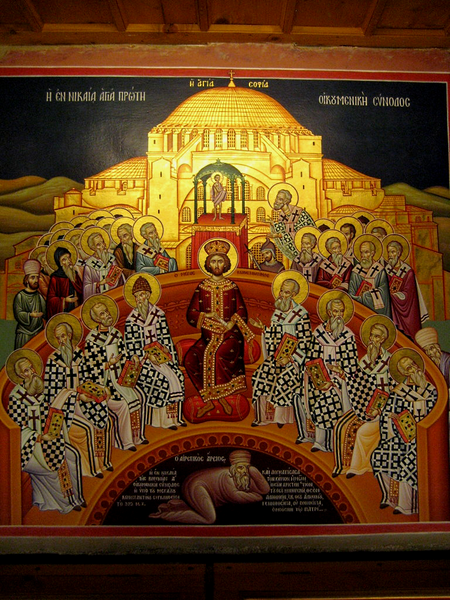The Council of Nicaea, with Arius depicted
as defeated by the council, lying under
the feet of Emperor Constantine.
______ 卐 ______
Below, abridged translation from the first
volume of Karlheinz Deschner’s Kriminalgeschichte
des Christentums (Criminal History of Christianity)
The Council of Nicaea and the profession of ‘Constantinian’ faith
Constantine had recommended the place, Nicaea, for the bonanza of its climate and had promised a pleasant stay. He was the one who convened the council, not the ‘Pope’. He also opened it on May 20 and held the presidency. The emperor paid the expenses of the participants, on whose number the data oscillate between 220 and 318 (for the 318 children of Abraham!). Silvestre, the supreme pastor of Rome, missed the meeting.
The emperor presented himself before the bishops ‘like an angel of God descending from heaven, resplendent in his bright garments, dazzling with light, with the fiery glow of purple and adorned with the clear gleam of gold and costly precious stones’ (Eusebius). The lords of the clergy themselves were guarded by guards and halberdiers ‘with sharp drawn swords’.
By decree of the sovereign they were ‘offered every day an opulent maintenance’. According to Eusebius, at a banquet ‘some sat at the table on the same cushions as the emperor, while others did on both sides. It could easily have been thought or imagined that it was an image of the kingdom of Christ, which was only a dream and not a reality’. As far as the dogmatic aspects are concerned—no recordings were made—, the great majority of these servants of God showed little or no interest, something that the host did not care about.
Although Constantine may not have led the sessions—a problem that has been much discussed—he did determine its course and make the decisions. For this he made sure to have the majority, and even imposed the decision formula. The formula was the somewhat changeable concept (which means the same, identical, but also similar, of the Greek homos) of the homousios of the homousia: the equality of the natures of the ‘Father’ and of the ‘Son’: ‘a sign of antagonism in front of science, which thought about the paths of Origen’ (Gentz).
In the Bible, not a single mention is made about it. That slogan—which, notoriously the emperor himself had formulated—had been opposed to the beliefs of the majority of the Eastern episcopate, even though it stemmed from Gnostic theology. The Monarchians had also used it, other ‘heretics’ (anti-Trinitarians). However, the young Athanasius, who accompanied Bishop Alexander as a deacon, ‘had not used it in his first writings as a motto of his theology’ (Schneemelcher) and ‘it took him 25 years to take a liking’ (Kraft). Although already in the council ‘he pronounced against Arianism’ and did not put it in writing until a quarter of century later.
No reasons were given nor was explained in more detail that decision of faith. The emperor, who was undeniably interested in unity and who considered the dispute of the clergy only as an intransigence, forbade any theological discussion and simply demanded compliance with the formula.
The ‘Holy Fathers’ (Athanasius), whose presence presumably gave the dictator a happiness ‘that exceeded any other’ and whom for a quarter of a year he honoured and covered them with honours, obeyed. And today, millions of Christians continue to believe in the fides Nicaena, the faith confession of Nicaea—which should be better called, according to Johannes Haller, the faith of Constantine: the work of a layman who was not even baptized. ‘We believe in one God, the almighty Father… and in one Lord, Jesus Christ… true God of the true God, begotten, not created, of the same nature (homousios) as the Father…’
In the West, the Nicaea confession of faith was still barely known a few decades later and in orthodox circles it was the subject of discussion. Even the father of the Church, Hilarius, initially opposed that baptismal faith; although he later returned to it. However, the holy bishop Zeno of Verona, a passionate enemy of the infidels and the Arians, mocked a creed that worked with formulas. At the end of the 4th century, in the sermons of Gaudentius of Brescia or Maximus of Turin, it is still mentioned ‘Nicaea at no time’ (Sieben, Jesuit).
Even Luther, in 1521, admits to hating ‘the word homousios’ although in 1539, in his work On the Councils and the Church he accepts it. Goethe is right when he affirms that ‘the dogma of the divinity of Christ decreed by the Council of Nicaea was very useful, even a necessity, for despotism’.
The behavior of Constantine was not in any way an isolated event. Since then, the emperors, and not the popes, were the ones who made the decisions about the Church. Throughout the 4th century the bishops of Rome did not play any decisive role in the synods nor were they determining authorities. From Constantine, the ‘imperial synodal power’ prevailed.
The confession of faith of the Arians, which contrasted the homoiusios (of a similar nature) to the homousios, was snatched from the speaker’s hands, in Nicaea, shattering the document before he had finished reading it. ‘At once it was rejected by all and branded as erroneous and false; there was a great tumult’ (Theodoret). In the sacred meetings, speaking through the mouth of Eusebius, a participant in them, there reigned ‘everywhere bitter disputes’, as was often the case in councils.
The emperor threw directly into the fire, without even reading them, the writings of complaints and quarrels of the bishops. All those who shared ‘of good will the best opinion’ received ‘his highest praises; on the contrary, he rejected the undisciplined with horror’.
Arius was again condemned.
